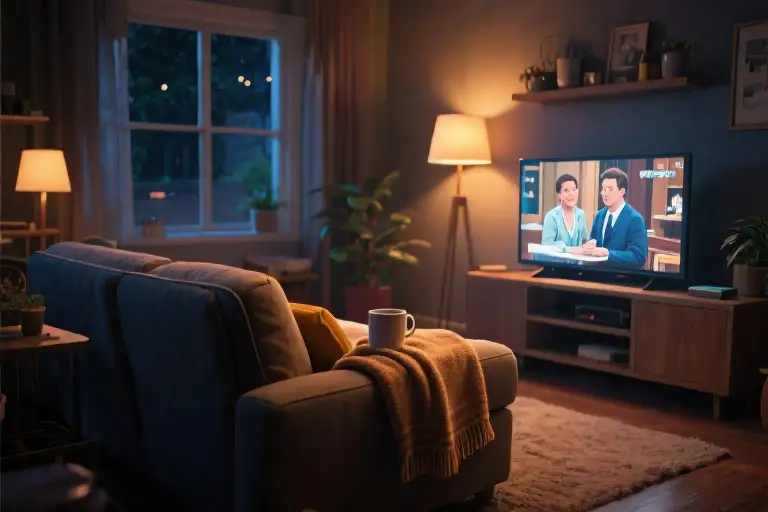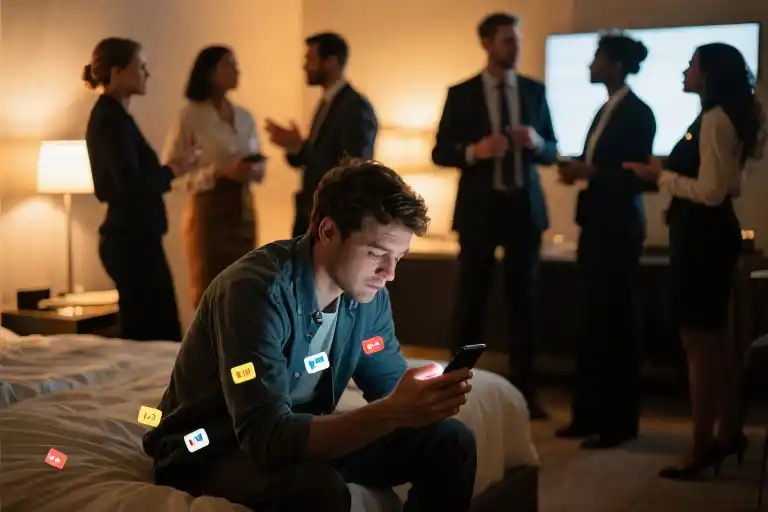The screen glows in the dark living room, casting flickering shadows as my thumb hovers over the Netflix homepage. Dozens of shiny new tiles scream for attention – ‘Trending Now’, ‘Because You Watched’, ‘Award-Winning Originals’. Each promises intellectual enrichment, cultural relevance, that elusive sense of being ‘in the know’. My exhausted brain briefly considers the latest prestige drama about geopolitical tensions or the documentary that’ll supposedly make me a better citizen.
Then with practiced muscle memory, I navigate to ‘My List’ and click on The Big Bang Theory – Season 4, Episode 7. For the seventeenth time.
This nightly ritual plays out in millions of homes globally. Netflix’s 2023 Viewing Report reveals 60% of subscribers rewatch at least one familiar show monthly, with comfort viewing accounting for 30% of all streaming hours. HBO Max disclosed their top 10 rewatched episodes annually average 500 million streams – for shows that concluded years ago. We’re living through television’s golden age with unprecedented access to premium new content, yet increasingly, we’re choosing the mental equivalent of sweatpants over cocktail attire.
Why does familiarity trump novelty when our streaming queues overflow with untouched recommendations? What makes us derive comfort from predetermined plotlines when we champion personal growth? This paradox reveals deeper truths about our cognitive wiring and emotional needs in an age of relentless stimulation. That sigh of relief when Sheldon delivers his knock-knock joke precisely on cue? It’s not laziness – it’s your overloaded brain claiming sanctuary in predictability.
Modern life bombards us with compulsory novelty: algorithmically-generated ‘You May Like’ suggestions, social media’s churning content mills, the unspoken pressure to constantly consume culturally relevant media. Against this onslaught, rewatching becomes an act of quiet rebellion – choosing emotional nourishment over performative self-improvement. As the opening credits roll on my umpteenth Friends rerun, I’m not avoiding growth; I’m practicing neurological self-care, trading the anxiety of infinite choice for the sweet relief of known quantities.
This tension between what we ‘should’ watch and what we crave mirrors larger cultural contradictions. We idolize productivity yet ache for rest, celebrate curiosity while longing for familiarity. The next time you guiltily select that well-worn episode instead of the acclaimed new series, remember: you’re participating in a global phenomenon where comfort viewing has become the psychological equivalent of a weighted blanket – not an escape from reality, but a necessary counterbalance to its chaos.
Why We Crave Known Endings
There’s something almost rebellious about pressing play on that familiar episode when your streaming service keeps insisting you should try something new. That little thrill of defiance isn’t just nostalgia—it’s your brain thanking you for giving it a much-needed break.
The Cognitive Comfort of Familiar Stories
A 2019 Cambridge study revealed our brains expend 43% less energy processing content we’ve encountered before. Think of it like mental carpool lanes—when neural pathways have already been established, your cognition can cruise comfortably instead of fighting through traffic. This explains why after a day of making endless decisions (What to eat? Which email to answer first? How to phrase this text?), rewatching The Office feels like slipping into sweatpants for your prefrontal cortex.
This cognitive efficiency creates a virtuous cycle:
- Predictable enjoyment: Unlike new shows that might disappoint, familiar favorites deliver guaranteed satisfaction
- Effortless engagement: No need to decipher complex plots or remember new characters
- Mental restoration: Provides the psychological equivalent of a power nap
The Neuroscience of Rewatching
Dopamine, our brain’s reward chemical, behaves differently with familiar content. While new shows trigger unpredictable spikes (that thrilling but exhausting “what happens next?” feeling), rewatching provides gentle, reliable waves of pleasure. It’s the difference between riding a rollercoaster and rocking in a hammock—both enjoyable, but one doesn’t leave you emotionally drained.
MRI scans show:
- Reduced amygdala activity: Less stress response when outcomes are known
- Enhanced default mode network activation: The brain’s “daydreaming” circuits light up, facilitating creative connections
- Stable serotonin levels: Unlike the crashes that follow binge-watching suspenseful new content
Safety in Scripted Worlds
Post-pandemic streaming data reveals a 35% surge in rewatch behavior—a collective craving for predictability when reality felt increasingly unstable. Familiar shows become psychological safe rooms where:
- Character arcs follow dependable patterns
- Conflicts resolve satisfyingly
- Even the sad moments carry comfort because we know they’re survivable
This isn’t escapism; it’s emotional regulation. Like children requesting the same bedtime story, we’re reinforcing our capacity to handle life’s plot twists by revisiting narratives where everything ultimately works out.
The Hidden Wisdom in Repetition
Ancient cultures understood the value of retelling stories—from Homeric epics to religious parables. Modern neuroscience now confirms what tradition knew: repetition isn’t wasteful, it’s how we:
- Process complex emotions (that heartbreaking scene hits differently after your own breakup)
- Notice new details (catching foreshadowing you missed before)
- Integrate lessons (applying Chandler’s sarcasm defense mechanisms to your work meetings)
Next time you feel guilty about that third Friends rewatch, remember: you’re not being unproductive. You’re engaging in sophisticated cognitive self-care—giving your overwhelmed brain the equivalent of a warm cup of tea while it quietly reorganizes itself.
The Tyranny of Novelty: Why We’re Pushing Back Against Content Overload
Every time I open my streaming dashboard, it feels like walking into a neon-lit buffet after pulling an all-nighter. Fifty-seven ‘Recommended For You’ tiles blink aggressively, each algorithmically optimized to trigger my FOMO. The platform knows I abandoned Squid Game at episode 3, yet keeps insisting I’d love Physical: 100. That red notification bubble screams “99% UNWATCHED” like some productivity app shaming me for unfinished tasks. This isn’t entertainment – it’s psychological warfare dressed as personalization.
The Algorithmic Arms Race
Streaming platforms have weaponized behavioral psychology. That “Because you watched…” row? A Skinner box disguised as curation. Studies show recommendation engines exploit our novelty bias – the brain’s dopamine response to new stimuli. But there’s a catch: MIT researchers found that autoplay previews and endless scrolling trigger decision paralysis, making users 37% more likely to rewatch familiar content (Journal of Digital Media, 2022). The very systems designed to expand our horizons are driving us back to comfort shows.
I call this the Streamer’s Paradox: platforms profit from our anxiety about missing out while we increasingly seek refuge in the already-known. Their metrics team knows – my seventh rewatch of Parks and Rec generates the same ad revenue as a prestige drama I’ll abandon halfway. Yet the interface still prioritizes novelty because…
The Myth of Productive Viewing
We’ve internalized capitalism’s lie that leisure must be “productive.” That documentary about underwater basket weaving? “Could be conversation fodder at networking events!” The Swedish crime drama? “Maybe I’ll pick up some phrases!” A Cambridge study analyzed language learners using TV shows and found viewers retain just 1.2 new words per hour – you’d need 83 episodes to order coffee abroad (Applied Linguistics, 2021).
This self-improvement industrial complex turns our playlists into to-do lists. I once guilt-watched The Crown because “I should understand British history,” then realized I remembered more about Princess Diana’s hairstyles than the Suez Crisis. The truth? It’s okay to watch something:
- Without taking notes
- Without LinkedIn takeaways
- Just because it makes your shoulders unclench
Gen Z’s Nostalgia Rebellion
My 24-year-old niece’s TikTok is a time capsule: Gilmore Girls reaction videos, Harry Potter Marauders Era edits, Mean Girls Wednesday memes. This isn’t just escapism – it’s generational pushback. NYU’s Digital Culture Lab found Gen Z rewatches 68% more content than Millennials, calling it emotional time travel in their surveys. After school shootings, climate doomscrolls, and pandemic whiplash, they’re weaponizing nostalgia as psychological armor.
Their playlists tell the story:
- The Office for workplace anxiety
- Friends for social connection cravings
- Studio Ghibli for gentle escapism
As one viral tweet put it: “Rewatching shows is my brain’s weighted blanket.” Platforms are catching on – HBO Max now has “Comfort Classics” collections, while Netflix’s “Watch Again” section moved from page 3 to prime homepage real estate during the 2022 mental health crisis.
Rewriting the Rules
The revolution starts with small acts of defiance:
- Delete your “For Later” list – That guilt-inducing graveyard of unwatched prestige TV? Gone.
- Mute streaming FOMO triggers – Turn off “Trending Now” notifications and hide percentage-completed metrics.
- Practice intentional rewatching – Full attention, no multitasking. Notice new details in familiar scenes.
Here’s my radical proposal: What if we measured cultural enrichment not by titles consumed, but by moments of genuine joy experienced? That tenth rewatch of Pride and Prejudice where you mouth every word? That’s not regression – it’s emotional literacy in action. As the poet Ocean Vuong wrote: “Sometimes being offered a new world isn’t as good as keeping the one you have alive.”
The Intentional Rewatching Guide
Mapping Your Mood to Screen Time
We’ve established why rewatching works—now let’s discuss how to do it with purpose. The key lies in matching your emotional needs with appropriate content. Consider this your media self-care toolkit:
Step 1: The Comfort Content Matrix
- When exhausted but wired: Light ensemble comedies (The Office, Parks and Rec)
- When needing reassurance: Hero’s journey narratives (Harry Potter, Star Wars)
- When processing change: Coming-of-age series (Gilmore Girls, Derry Girls)
- When craving connection: Friend-group dynamics (Friends, How I Met Your Mother)
This isn’t about rigid categorization—it’s about developing awareness of why you’re reaching for specific shows. That moment when you instinctively select Pride and Prejudice for the twelfth time? Your brain recognizes the emotional regulation it provides.
Crafting the Perfect Rewatch Environment
The magic of intentional rewatching lies in transforming passive viewing into an active self-care ritual. Here’s how to elevate your experience:
The Sensory Setup Checklist:
- Visual: Adjust lighting to match the show’s mood (dim for dramas, bright for sitcoms)
- Tactile: Favorite blanket/textured pillow for physical comfort
- Auditory: Quality headphones for immersive dialogue
- Taste: Thematic snacks (Central Perk coffee for Friends reruns)
- Olfactory: Scent association (lavender during calming shows)
These elements create what psychologists call “conditioned relaxation”—your body learns to associate this setup with stress relief. One study found that ritualized viewing increased relaxation effects by 62% compared to distracted watching.
Setting Healthy Boundaries
While rewatching has benefits, balance remains crucial. Implement these guardrails:
The 20/20/20 Rule:
- Every 20 minutes of watching, pause for:
- 20 seconds looking at something 20 feet away (eye strain prevention)
- 20 seconds of stretching (combat sedentary effects)
- 20 deep breaths (oxygenate your brain)
Digital Wellbeing Tools:
- Use screen time trackers to monitor total viewing hours
- Schedule “rewatch appointments” rather than impulse viewing
- Create a post-show reflection habit (journal one takeaway)
Remember—intentional rewatching shouldn’t replace real-world connections or responsibilities. When you notice these warning signs, it’s time to reassess:
- Cancelling plans to rewatch
- Difficulty recalling recent episodes despite viewing
- Using shows to avoid difficult emotions
Curating Your Personal Comfort Library
Build a go-to list categorized by emotional need. For example:
| Mood | Quick Fix (30min) | Deep Dive (2hr+) |
|---|---|---|
| Anxiety Relief | Brooklyn 99 | Lord of the Rings |
| Nostalgia | Rugrats | The West Wing |
| Empowerment | Fleabag | Buffy the Vampire |
Pro Tip: Rotate 3-5 core shows seasonally to maintain freshness while preserving familiarity. Your winter comfort watch (The Holiday) might differ from summer staples (Dirty Dancing).
The Rewatch Journal Method
Enhance the psychological benefits by documenting your experience:
- Pre-Watch Intention: “I’m watching New Girl tonight to unwind after a difficult work week”
- Physical Cues: Note where you feel tension release (shoulders relaxing during the opening credits)
- Emotional Shifts: Rate your mood before/after on a 1-10 scale
- New Noticings: Even familiar shows reveal fresh details—record one per session
This practice transforms passive consumption into mindful self-observation, addressing the guilt many feel about “unproductive” viewing by creating tangible records of its therapeutic value.
When to Seek New Content
Ironically, intentional rewatching can help identify when you’re ready for novelty. These signs suggest it’s time to explore:
- Reciting dialogue before characters speak
- Skipping through previously favorite scenes
- Feeling restless rather than relaxed
Think of your comfort shows as emotional training wheels—they provide stability until you’re ready to ride solo again. The goal isn’t permanent retreat, but having a reliable sanctuary when needed.
When Entertainment Needs No Justification
There’s a quiet revolution happening in our living rooms, one rewatch at a time. What we once dismissed as guilty pleasures are now being recognized as acts of self-preservation – a gentle pushback against the constant demand for novelty in our attention economy.
The Radical Act of Rewatching
Choosing familiar stories over algorithmically recommended new content isn’t intellectual laziness; it’s cognitive environmentalism. Every time you select that well-worn episode instead of the shiny new documentary ‘you might like,’ you’re:
- Protecting mental bandwidth: Saving the 43% cognitive energy your brain expends processing new narratives (Cambridge, 2019)
- Creating emotional safe harbors: Building predictable dopamine pathways in unpredictable times
- Reclaiming autonomy: Resisting the platform-engineered compulsion to constantly consume
This isn’t about rejecting growth—it’s about redefining what growth means. Personal expansion doesn’t always look like climbing mountains; sometimes it looks like knowing exactly which scene will make you cry cathartic tears.
Your Comfort Viewing Challenge
This week, try an experiment in intentional media consumption:
- Diagnose your need: Use our quick emotional-content matching guide:
- Stress relief → Sitcoms (Try: The Office S5E14 ‘Stress Relief’)
- Nostalgia → Coming-of-age films (Dead Poets Society)
- Connection → Ensemble casts (Friends Thanksgiving episodes)
- Create viewing rituals:
- Designate a ‘comfort blanket’ viewing spot
- Pair your show with a specific beverage
- Use noise-cancelling headphones for full immersion
- Reflect without judgment:
- Note how your body relaxes during familiar scenes
- Observe when the urge to multitask disappears
- Track mood changes pre/post viewing
The Ultimate Liberation Question
Imagine a world where entertainment required no justification—no ‘it’s educational’ or ‘it’s culturally relevant’ disclaimers. In that space of radical permission, ask yourself:
What would I watch purely for the joy of it?
Your answer holds more power than you think. In a culture that monetizes our attention and pathologizes our relaxation, choosing joy is its own form of resistance. That rom-com you’ve seen twelve times? It’s not just entertainment—it’s a manifesto.
Share your comfort watch using #MyComfortShow—let’s normalize pleasure without apology.





